
Praxiteles of Athens, the son of Cephisodotus the Elder, was the most renowned of the Attica sculptors of the 4th century BC. He was the first to sculpt the nude female form in a life-size statue. While no indubitably attributable sculpture by Praxiteles is extant, numerous copies of his works have survived; several authors, including Pliny the Elder, wrote of his works; and coins engraved with silhouettes of his various famous statuary types from the period still exist.

The statue of Athena Parthenos was a monumental chryselephantine sculpture of the goddess Athena. Attributed to Phidias and dated to the mid-fifth century BCE, it was an offering from the city of Athens to Athena, its tutelary deity. The naos of the Parthenon on the acropolis of Athens was designed exclusively to accommodate it.
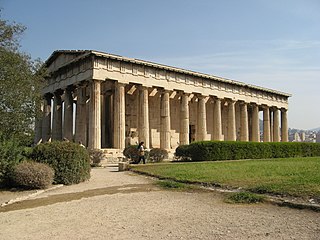
The Temple of Hephaestus or Hephaisteion, is a well-preserved Greek temple dedicated to Hephaestus; it remains standing largely intact today. It is a Doric peripteral temple, and is located at the north-west side of the Agora of Athens, on top of the Agoraios Kolonos hill. From the 7th century until 1834, it served as the Greek Orthodox church of Saint George Akamates. The building's condition has been maintained due to its history of varied use.

The ancient Agora of Athens is the best-known example of an ancient Greek agora, located to the northwest of the Acropolis and bounded on the south by the hill of the Areopagus and on the west by the hill known as the Agoraios Kolonos, also called Market Hill. The Agora's initial use was for a commercial, assembly, or residential gathering place.
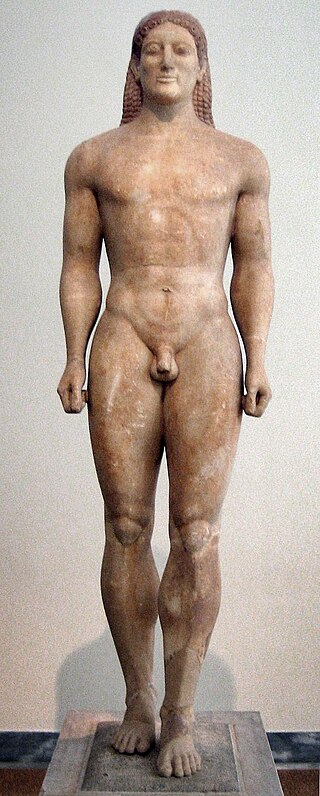
Kouros is the modern term given to free-standing Ancient Greek sculptures that depict nude male youths. They first appear in the Archaic period in Greece and are prominent in Attica and Boeotia, with a less frequent presence in many other Ancient Greek territories such as Sicily. Such statues are found across the Greek-speaking world; the preponderance of these were found in sanctuaries of Apollo with more than one hundred from the sanctuary of Apollo Ptoion, Boeotia, alone. These free-standing sculptures were typically marble, but the form is also rendered in limestone, wood, bronze, ivory and terracotta. They are typically life-sized, though early colossal examples are up to 3 meters tall.

Paeonius of Mende, Chalkidiki was a Greek sculptor of the late 5th century BC. He most likely received his early training in Northern Greece and is thought to have later adapted Athenian stylistic elements into his own work, based upon his probable interaction with the Olympia workshop of Phidias. In any case, he was "attic-trained."

Rhamnous, also Ramnous or Rhamnus, was an ancient Greek city in Attica situated on the coast, overlooking the Euboean Strait. Its ruins lie northwest of the modern town of Agia Marina in the municipality of Marathon.

The sculpture of ancient Greece is the main surviving type of fine ancient Greek art as, with the exception of painted ancient Greek pottery, almost no ancient Greek painting survives. Modern scholarship identifies three major stages in monumental sculpture in bronze and stone: the Archaic, Classical (480–323) and Hellenistic. At all periods there were great numbers of Greek terracotta figurines and small sculptures in metal and other materials.

Classical sculpture refers generally to sculpture from Ancient Greece and Ancient Rome, as well as the Hellenized and Romanized civilizations under their rule or influence, from about 500 BC to around 200 AD. It may also refer more precisely a period within Ancient Greek sculpture from around 500 BC to the onset of the Hellenistic style around 323 BC, in this case usually given a capital "C". The term "classical" is also widely used for a stylistic tendency in later sculpture, not restricted to works in a Neoclassical or classical style.

The study of Roman sculpture is complicated by its relation to Greek sculpture. Many examples of even the most famous Greek sculptures, such as the Apollo Belvedere and Barberini Faun, are known only from Roman Imperial or Hellenistic "copies". At one time, this imitation was taken by art historians as indicating a narrowness of the Roman artistic imagination, but, in the late 20th century, Roman art began to be reevaluated on its own terms: some impressions of the nature of Greek sculpture may in fact be based on Roman artistry.
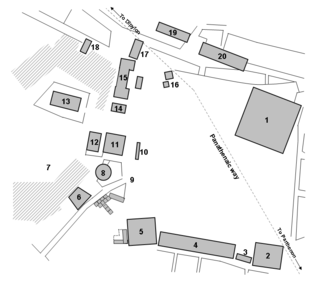
Stoa Basileios, meaning Royal Stoa, was a Doric stoa in the northwestern corner of the Athenian Agora, which was built in the 6th century BC, substantially altered in the 5th century BC, and then carefully preserved until the mid-second century AD. It is among the smallest known Greek stoas, but had great symbolic significance as the seat of the Athenian King Archon, repository of Athens' laws, and site of "the stone" on which incoming magistrates swore their oath of office.

The Temple of Ares was a Doric hexastyle peripteral temple dedicated to Ares, located in the northern part of the Ancient Agora of Athens. Fragments from the temple found throughout the Agora enable a full, if tentative, reconstruction of the temple's appearance and sculptural programme. The temple had a large altar to the east and was surrounded by statues. A terrace to the north looked down on the Panathenaic Way. The northwest corner of the temple overlays one of the best-preserved Mycenaean tombs in the Agora, which was in use from ca. 1450-1000 BC.

Delphi Archaeological museum is one of the principal museums of Greece and one of the most visited. It is operated by the Greek Ministry of Culture. Founded in 1903, it has been rearranged several times and houses the discoveries made at the Panhellenic sanctuary of Delphi, which date from the Late Helladic (Mycenean) period to the early Byzantine era.
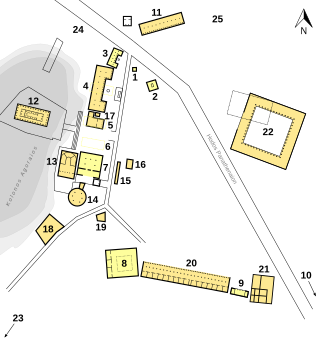
The Temple of Apollo Patroos is a small ruined temple on the west side of the Ancient Agora of Athens. The original temple was an apsidal structure, built in the mid-sixth century BC and destroyed in 480/79 BC. The area probably remained sacred to Apollo. A new hexastyle ionic temple was built ca. 306-300 BC, which has an unusual L-shaped floor plan. Some fragments from the sculptural decoration of this structure survive. The colossal cult statue, by Euphranor, has also been recovered.
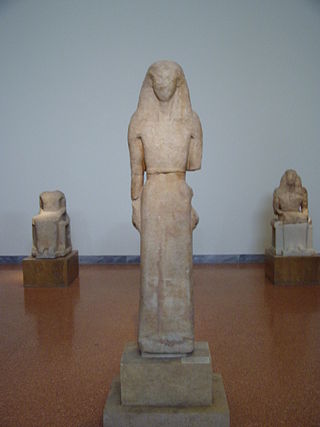
The Dedication of Nikandre is a Greek marble sculpture, made approximately around 650 BCE, held in the National Archaeological Museum, Athens, Greece. Nikandre, a woman from the island of Naxos, dedicated the statue in the temple of Artemis at Delos, the birthplace of Apollo and Artemis. The statue, which was found during archaeological excavation in the 19th century, is one of the earliest surviving korai, or statues of women, and displays one of the oldest inscriptions of Ancient Greek in stone. Its representation and its placement within the existing stylistic periods of Greek sculpture have become the subject of extensive scholarship.

The Despinis Head is part of a colossal ancient Greek sculpture, depicting a female head, which was conserved in the store rooms of the Archaeological Museum of the Ancient Agora in Athens until recently. According to George Despinis, director of the museum, it was originally part of the statue of Artemis Brauronia carved by Praxiteles.

The Kore of Lyons is a Greek statue of Pentelic marble depicting a bust of a young girl of the kore type, conserved at the musée des beaux-arts de Lyon, France. Deriving from the Athenian Acropolis, it is generally dated to the 540s BC. Considered the centrepiece of the museum's antiquities department, the statue was acquired between 1808 and 1810.

The Statue of the priestess Aristonoe in the National Archaeological Museum Athens (NAMA), with the inventory number 232, dates from the third century BC.

The Temple of Poseidon is an ancient Greek temple on Cape Sounion, Greece, dedicated to the god Poseidon. There is evidence of the establishment of sanctuaries on the cape from as early as the 11th century BC. Sounion's most prominent temples, the Temple of Athena and the Temple of Poseidon, are however not believed to have been built until about 700 BC, and their kouroi date from about one hundred years later. The material and size of the offerings at the Temple of Poseidon indicate that it was likely frequented by members of the elite and the aristocratic class.
The Cave Sanctuaries of the Acropolis of Athens are the natural fissures in the rock of the Acropolis hill that were used as sites of worship for deities of the Panhellenic pantheon in antiquity. Traditionally a sharp distinction has been drawn between the state religion practised on the summit of the Acropolis and the cult practice of the shrines on the lower slopes. Recently, however, interest has burgeoned in the individual religious experience or personal piety in Greek society of which these cult sites may be the expression. The proceeding description follows the order of the shrines from the Klepsydra at the northwest face of the Acropolis clockwise via the Peripatos round to the foot of the Nike bastion.





















